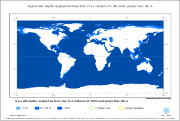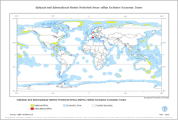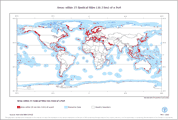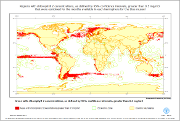Offshore mariculture
Type of resources
Available actions
Topics
Keywords
Contact for the resource
Provided by
Formats
Representation types
Update frequencies
status
Scale
-

This dataset includes the regions with sea depths ranging from lower than 25 m, between 25-100 m and greater than 100 m.
-
The Global Administrative Areas (GADM) 3.6 vector dataset series is the world coverage for administrative units at different administrative levels. Delimiting a total of 386,735 boundaries, GADM open data project delivers distinct datasets representing administrative boundaries for each country and its respective political subdivisions. The dataset series is comprised of the six administrative levels global datasets for: National (level 0), State/province/equivalent (level 1), County/district/equivalent (level 2), Commune/municipality/equivalent (level 3) and smaller Levels 4 and 5. Attributes for Level 0 comprise country name in English and ISO 3166-1 alpha3 coding. Administrative units associated with attribute information include official names in Latin and non-Latin scripts, variant names, administrative type in local and English. Administrative Level 4 is available for 20 countries and Level 5 for France and Rwanda.
-
The Administrative boundaries at the level 5 dataset are part of the Global Administrative Areas (GADM) 3.6 vector dataset series which includes distinct datasets representing administrative boundaries for all countries in the world. The Administrative level 5 distinguishes sub-national administrative boundaries smaller than Communes and Municipalities and is available for France and Rwanda. GADM makes use of high spatial resolution images, and an extensive set of attributes to map administrative areas at all levels of political sub-division. Information on administrative units associated attributes includes official names in Latin and non-Latin scripts, variant names, administrative type in local an English. Please read the GADM 3.6 - Global Administrative Areas dataset series metadata for more information.
-
The Global Administrative Areas (GADM) 3.6 vector dataset series is the world coverage for administrative units at different administrative levels. Delimiting a total of 386,735 boundaries, GADM open data project delivers distinct datasets representing administrative boundaries for each country and its respective political subdivisions. The dataset series is comprised of the six administrative levels global datasets for: National (level 0), State/province/equivalent (level 1), County/district/equivalent (level 2), Commune/municipality/equivalent (level 3) and smaller Levels 4 and 5. Attributes for Level 0 comprise country name in English and ISO 3166-1 alpha3 coding. Administrative units associated with attribute information include official names in Latin and non-Latin scripts, variant names, administrative type in local and English. Administrative Level 4 is available for 20 countries and Level 5 for France and Rwanda.
-
The Country boundaries at level 0 dataset is part of the Global Administrative Areas (GADM) 3.6 vector dataset series which includes distinct datasets representing administrative boundaries for all countries in the world. GADM makes use of high spatial resolution images and an extensive set of attributes to map administrative areas at all levels of political sub-division. The National level 0 attributes comprise country name in English and ISO 3166-1 alpha3 coding. Please read the GADM 3.6 - Global Administrative Areas dataset series metadata for more information.
-
The Administrative boundaries at the level 4 dataset are part of the Global Administrative Areas (GADM) 3.6 vector dataset series which includes distinct datasets representing administrative boundaries for all countries in the world. The Administrative level 4 distinguishes sub-national administrative boundaries smaller than Communes and Municipalities and is available for 20 countries. GADM makes use of high spatial resolution images, and an extensive set of attributes to map administrative areas at all levels of political sub-division. Information on administrative units associated attributes includes official names in Latin and non-Latin scripts, variant names, administrative type in local an English. Please read the GADM 3.6 - Global Administrative Areas dataset series metadata for more information.
-

This polygon layer combines marine protected areas from the World Dataset of Protected Areas (UNEP-WCMW) and the Exclusive Economic Zones (VLIZ2009 - Flanders Marine Institute, Belgium) so that it reflects only marine portions of protected areas that have Exclusive Economic Zone attribute values. The dataset is also split into the following Geographic Zones: Arctic, Temperate, Intertemperate, Antarctic.
-

For the Global Ocean, climatology of the chlorophyll-a concentration for case 1 water (expressed in mg/m3). The climatology is based on the GlobColour (http://www.globcolour.info) products obtained by the merging of MERIS MODIS and SeaWIFS data available during the period 1998-2009. The "Minimum/Maximum" product represents for each pixel, the observed range of data when computing the chlorophyll-a concentration product by merging for each of the 12 years the selected month (April). The spatial resolution of the product is about 4km. The product has been designed and produced by ACRI-ST INFOCEAN-DESK environment monitoring service from EU FP7 & ESA MyOcean GlobColour Products, ESA ENVISAT MERIS data, NASA MODIS and SeaWiFS data. The GlobColour project has been initiated and funded by the ESA Data User Element Programme to develop a satellite based ocean colour data service to support global carbon-cycle research. The GlobColour project has largely benefited from NASA contributions, including the availability of the MODIS and SeaWiFS products; the in situ data base of radiometric and phytoplankton pigment data, and other oceanographic and atmospheric data: the SeaWiFS Bio-optical Archive and Storage System - SeaBASS (Werdell and Bailey, 2002). The global merged chlorophyll-a concentration for case 1 water is obtained by the merging of MERIS, MODIS and SeaWiFS data using an advanced retrieval based on fitting an in-water bio-optical model to the merged set of observed normalised water-leaving radiances (nLw?s). This technique is termed GSM because it originates from the Garver et al. (1997) bio-optical model (Maritorena and Siegel, 2005). More details are available at http://www.globcolour.info/CDR_Docs/GlobCOLOUR_PUG.pdf.
-

This polygon layer reflects marine areas within 25 nautical miles travel distance of ports, combined by country, and split by depth range, economic zone and geographic zone. The dataset is derived from port points (World Port Index - NGA-USA), bathymetry data (GEBCO_08) and exclusive economic zones (VLIZ2009 - Flanders Marine Institute, Belgium).
-

This dataset identifies all regions in which the full 95% confidence interval is greater than 0.5 mg/m3 that were combined for the months available in each hemisphere for the blue mussel. The chlorophyll 2 data includes the mean chlorophyll 2 level per month, the standard deviation and the number of observations used to calculate the mean. Based on these values, the 95% upper and lower confidence levels about the mean for each month have been generated.
 FAO Map Catalog
FAO Map Catalog